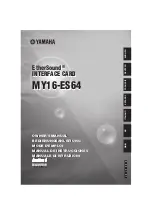
Defective Cable(s)
Video input cable or DB15 cable has an open or short.
Video Input
Defective or incompatible video source.
Defective PIXCI SV4 imaging board Defective integrated circuit, bad solder joint,
physical damage, or static damage.
Motherboard
No PCI burst mode or no PCI BIOS.
Defective PCI connector.
PCI slot is not bus master capable.
S/VGA
S/VGA board is too slow, has insufficient memory, or is not an AGP or PCI board.
9.2.1. Power Supply Problems
The PC power supply usually has a printed rating of power available for the four standard PC voltages. The PIXCI® SV4 imaging
board uses 500 milliamps from the +5 volt supply and 200 milliamps from the +12 volt supply. If other devices and the PIXCI®
SV4 imaging board use more power than the power supply can provide, the power supply will shut down. In marginal situations,
this may not happen until an operation is performed that requires additional power, such as increasing the number of pixels per
line. Try removing non-essential boards from the system.
9.2.2. Touching Boards
If the components of one board touch those of another, damage to one or both boards can occur. Move one of the touching
boards at least one slot away from the other.
9.2.3. Defective Cable
If a video input cable or DB15 cable is broken or shorted, the input or output will not be connected properly.
Try another cable.
Test the video or DB15 cable for shorts or opens with an ohmmeter.
Test the video cable by connecting the video source directly to a monitor.
9.2.4. Video Input
If the video source is defective or incompatible, a blue image will be captured.
Connect the video source directly to a monitor or oscilloscope and observe the signal.
If the video signal is present, but is not digitized correctly, the camera lens may be closed or the cap may be covering the
lens.
The XCAP software may have a different video input connector selected than the video input connector with the desired
video source. Check the video input mux software selection.
9.2.5. Motherboard
If the motherboard does not support PCI burst mode, does not have a PCI BIOS, or the PIXCI® SV4 imaging board does
not operate correctly, try another motherboard. Call EPIX for a list of suggested motherboards.
The PCI bus connector on the motherboard may be defective. Try another PCI bus slot or another motherboard.
The PCI bus slot may not support a PCI master. Try another PCI bus slot or another motherboard.
9.2.6. S/VGA Board
If the S/VGA board has insufficient memory, is not a PCI board, does not support PCI burst mode, or the XCAP software does
PIXCI® SV4 User's Manual
http://www.epixinc.com/manuals/pixci_sv4/index.htm
48 of 50
1/29/2016 11:23 AM
Artisan Technology Group - Quality Instrumentation ... Guaranteed | (888) 88-SOURCE | www.artisantg.com




































